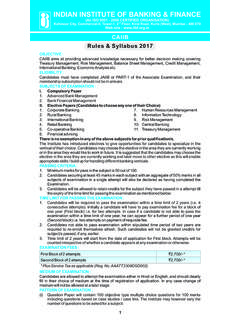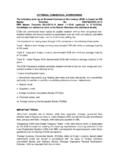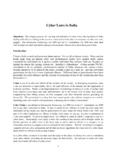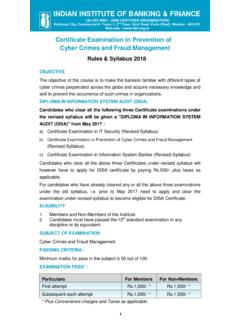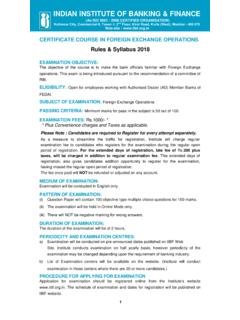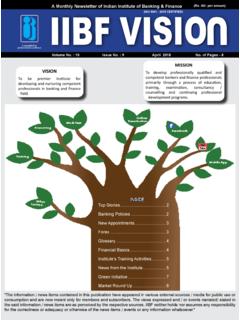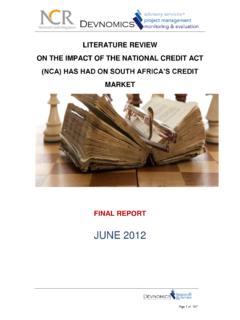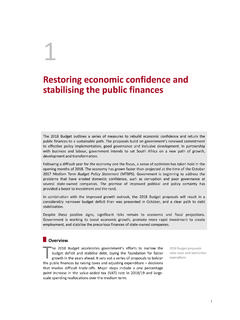Transcription of Updating the courseware for CAIIB Main subjects--- ABM ...
1 1 Updating the courseware for CAIIB Main subjects--- ABM--- Credit Management Chapter 26 Overview of Credit Management (1) priority sector lending - Targets and Classification RBI makes changes in the targets and classification of priority sector lending as and when the changing social/economic conditions demand so. The latest position is given in the Master Circular (PCB). :11 dated July 1, 2015. The salient features are as under: No loan related and ad-hoc service charges/inspection charges should be levied on priority sector loans up to Rs. 25,000. In the case of eligible priority sector loans to SHGs/ JLGs, this limit will be applicable per member and not to the group as a whole. The target is mentioned as a percentage of Adjusted Net Bank Credit (ANBC) (total loans and advance minus bills rediscounted with RBI and other Financial Institutions plus investments made after August 30, 2007 in non-SLR bonds under HTM category) or Credit Equivalent Amount of Off-Balance Sheet Exposure (OBE), whichever is higher as on March 31 of the previous year.
2 The overall target is 40% for domestic banks and foreign banks. Foreign banks with less than 20 branches have to achieve this in a phased manner within banks with 20 branches and above have to achieve the Total priority sector Target within a maximum period of five years starting from April 1, 2013 and ending on March 31, 2018. There are sub-targets, within the overall target, for Agriculture (18%), Micro-enterprises ( %) ( 7% by March 2016 and by March 2017) and Weaker sections (10%). Detailed description of activities eligible to be classified as priority sector are given in the above mentioned circular. Some of such activities/loans are given below. Loans to individuals for educational purposes for studies in India including vocational courses up to Rs. 10 lakh will be considered as eligible for priority sector .
3 Bank loans up to a limit of crore per borrower for building social infrastructure for activities namely schools, health care facilities, drinking water facilities and sanitation facilities including construction/ refurbishment of household toilets and household level water improvements in Tier II to Tier VI centers and bank credit to Micro Finance Institutions (MFIs) extended for on-2 lending to individuals and also to members of SHGs/JLGs for water and sanitation facilities, will be eligible for categorization as priority sector under Social Infrastructure , subject to certain conditions. The following are also eligible to be considered for priority sector : i. Bank loans up to a limit of Rs. 15 crore to borrowers for purposes like solar based power generators, biomass based power generators, wind mills, micro-hydel plants and for non-conventional energy based public utilities viz.
4 Street lighting systems, and remote village electrification. For individual households, the loan limit will be Rs. 10 lakh per borrower. ii. Loans not exceeding Rs. 50,000/- per borrower provided directly by banks to individuals and their SHG/JLG, provided the individual borrower s household annual income in rural areas does not exceed ,000/- and for non-rural areas it does not exceed Rs. 1,60,000/-. iii. Loans to distressed persons [other than farmers included under III ( ) A (v)] not exceeding Rs. 100,000/- per borrower to prepay their debt to non-institutional lenders. iv. Loans sanctioned to State Sponsored Organizations for Scheduled Castes/ Scheduled Tribes for the specific purpose of purchase and supply of inputs and/or the marketing of the outputs of the beneficiaries of these organizations.
5 Overdraft in PMJDY accounts: Overdrafts extended by banks upto Rs. 5,000/- in Pradhan Mantri Jan-Dhan Yojana (PMJDY) accounts will be eligible for classification under priority sector advances ( others category) as also weaker sections, provided the borrower s household annual income does not exceed Rs. 60,000/- for rural areas and ,20,000/- for non-rural areas. (2) Streamlining flow of credit to Micro and Small Enterprises (MSEs) (Details in RBI circular dated August 27, 2015) Micro and small units are more prone to facing financial difficulties during their Life Cycle than large enterprises / corporates when the business conditions turn adverse. Absence of timely support at such a juncture could lead to the unit turning sick and many a times irreversibly. Accordingly, banks have been advised to put in place Board approved policy on lending to MSEs, adopting an appropriate system of timely and adequate credit delivery to borrowers in the MSE segment within the broad prudential regulations of Reserve Bank of India.
6 Banks are also advised to ensure that their lending policies for MSEs are streamlined and made flexible in order 3 to empower the officials concerned to take quick decisions on credit delivery to MSEs..On August 27, 2015, RBI advised the banks to review their lending policies and mayadopt the following measures so as to facilitate timely and adequate availability of credit to viable MSE borrowers especiallywhen they are in need of fundsduring unforeseen circumstances. i) Standby Credit Facility Banks are allowed, at the time of sanction of project loans, to sanction a standby credit facility to fund unforeseen project cost overruns, if needed. Such standby credit facilities are sanctioned at the time of initial financial closure; but disbursed only when there is a cost overrun.
7 At the time of credit assessment of borrowers / project, such cost overruns are also taken into account while determining viability and repayment ability of the borrower. Banks may, as part of their lending policy to MSEs, consider a similar approach of providing a standby credit facility , while funding capital expenditure, to fund unforeseen increases in capital expenditure. Further, at the discretion of banks, such standby credit facility may also be sanctioned to fund periodic capital expenditure. The objective of such standby credit facility would be, among others, to extend credit speedily so that the capital asset creation is not delayed and commercial production can commence at the earliest. ii) Working Capital Limits Banks may also incorporate, in their lending policy to MSEs, a policy for fixing a separate additional limit, at the time of sanction / renewal of working capital limits, specifically for meeting the temporary rise in working capital requirements arising mainly due to unforeseen / seasonal increase in demand for products produced by them.
8 Such limits may be released primarily, where there is sufficient evidence of increase in the demand for products produced by MSEs. Banks may also sanction ad-hoc limits subject to the extant prudential norms, to be regularized not later than three months from the date of sanction. iii) Review of Regular Working Capital Limits Banks review working capital limits at least once in a year based on audited financial statements. However, audited financial statements of MSE units would ordinarily be available with a time lag, post-closing of the financial year. In such cases and where banks are convinced that changes in the demand pattern of MSE borrowers require a mid-term review, they may do so. Such mid-term reviews may be based on an assessment of sales performance of the MSEs since last review without waiting for audited financial statements.
9 However, such mid-term reviews shall be revalidated during the subsequent regular review based on audited financial statements. 4 iv) Timelines for Credit Decisions Timely credit is critical to the growth of a healthy MSE sector . Towards this Reserve Bank has issued several guidelines. On May 9, 2013, banks were advised to put in place a structured monitoring mechanism for holistic monitoring of all credit related matters, pertaining to MSE sector . Banks were also advised to have a Credit Proposal Tracking System (CPTS) with a view to closely track the applications and ensure speedy disposal. Further, Guidelines on Fair Practices Code for Lenders , advised that the time frame within which loan applications up to lakh will be disposed of should be indicated at the time of acceptance of loan applications.
10 Banks were also advised that they should clearly delineate the procedure for disposal of loan proposals, with appropriate timelines, and institute a suitable monitoring mechanism for reviewing applications pending beyond the specified period, without any compromise on due diligence requirements. Banks are also required to make suitable disclosures on the timelines for conveying credit decisions through their websites, notice-boards, product literature, etc. RBI has now advised the banks that the above systems should be put in place with regard to credit facilities (regular, additional / ad-hoc credit facilities and restructuring of accounts, if considered viable) for MSE borrowers. (3) Common guidelines / instructions for lending to MSME sector (Details in Master Circular dated July 1, 2015) 1 Issue of Acknowledgement of Loan Applications to MSME borrowers Banks have been advised to mandatorily acknowledge all loan applications, submitted manually or online, by their MSME borrowers and ensure that a running serial number is recorded on the application form as well as on the acknowledgement receipt.
